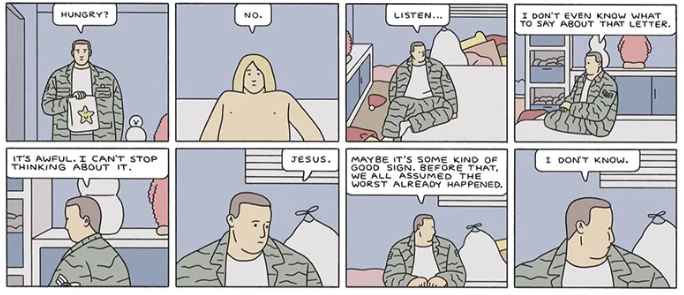Over the weekend and this week, you should be finishing up your comic literacy narratives and putting together your Halfa Kucha presentations.
Sketches
Note: I revised the schedule slightly to move sketch 10 back one week. There is no sketch due on 11/17, to allow you to focus on your presentations.
In class this week, I’ll hand out sheets of 11×17″ paper that you can fold into 5 “panels” for sketch 10. It’s also fine to do that sketch with 8.5×11″ paper, but with all the folding the larger sheets will likely work better — working with a standard 8.5×11″ page means that your first panel is only about 2″x3″ and that might be a challenge to draw on.
Looking ahead to the Thanksgiving break, you’ll be recreating a scene from a movie … just be sort of thinking about what you might be able to manage to do with that sketch.
Half Kucha
As you read for class this week you should be thinking about and preparing for your presentations. It’s probably a good idea to look back over your Tracing Pages essay as you do so. That assignment asked you to think about trauma and healing by zooming in very narrowly on two pages. This assignment is asking you to think about trauma and recovery from more of a middle distance — looking for patterns across two or three of the books we have read this semester.
In the assignment prompt, I ask you to think about those two quotes from Herman and also the Hillary Chute essay on “The Risk of Representation.” You might think about the quotes from that essay that we worked on as a class.
Some other key ideas you might consider:
- the ways in which a comics artist “push on conceptions of the unrepresentable” and “assert the value of presence, however complex and contingent”;
- the ways in which these authors “offer the work of retracing — materially reimagining trauma. They return to events to literally re-view them”;
- the ways in which these narratives “are not only about events but also, explicitly, about how we frame them;
- the ways in which an author “insists on the importance of innovative textual practice offered by the rich visual-verbal form of comics to be able to represent trauma productively and ethically”;
- the idiom of witness: “a manner of testifying that sets a visual language in motion with and against the verbal in order to embody individual and collective experience, to put contingent selves and histories into form”;
- the ways in which these authors “show us interpretation as a process of visualization”;
- comics as a “possible metaphor for memory and recollection” in the way that comics “appear in fragments, just as they do in actual recollection,” especially when you’re dealing with traumatic memory;
- the ways in which these authors represent “an everyday reality,” especially for women and girls, “picturing what is often placed outside of public discourse”;
- authors using the “inbuilt duality of the form — its word and image cross-discursivity — to stage dialogues among versions of the self, underscoring the importance of an ongoing, unclosed project of self-representation and self-narration”;
- the ways in which comics represent time as space: “time is shaped spatially” on a page through panel size, shape, and placement, which interacts with pace and rhythm and allows for “palimpsesting past and present moments together” in order to show the past, present, and future all together simultaneously;
- the similarities and differences between comics and film, and in particular for this assignment the ways in which comics might be better at representing trauma and healing because comics “cedes the pace of consumption to the reader, and begs rereadings through its spatial form,” thus “releasing its reader from the strictures of experiencing a work in a controlled time frame,” which can have a profound impact when dealing with the ethical implications of presenting traumatic narratives or disturbing images (for example, avoiding the problem of the camera lingering too long on an image of atrocity or “wash over it too casually”);
- because of comics’ “rhythm of acquisition” they are “capable of taking up complex political and historical issues with an explicit, formal degree of self-awareness”;
- the ways in which comics can feel diaristic: “there is an intimacy to reading handwritten marks on the printed page, an intimacy that works in tandem with the sometimes visceral effects of presenting ‘private’ images” (all quotes in this list from Chute, Hillary. “Introduction: Women, Comics, and the Risk of Representation.” Graphic Women: Life Narrative and Contemporary Comics. New York: Columbia UP, 2010. 1-27.)
Obviously, you should not try to tackle all of these in your analysis. But you might read through that list and pay attention to one that intrigues you and/or helps you to understand something complex about the books we’ve read this semester, then try to lay out that understanding in your presentation.







